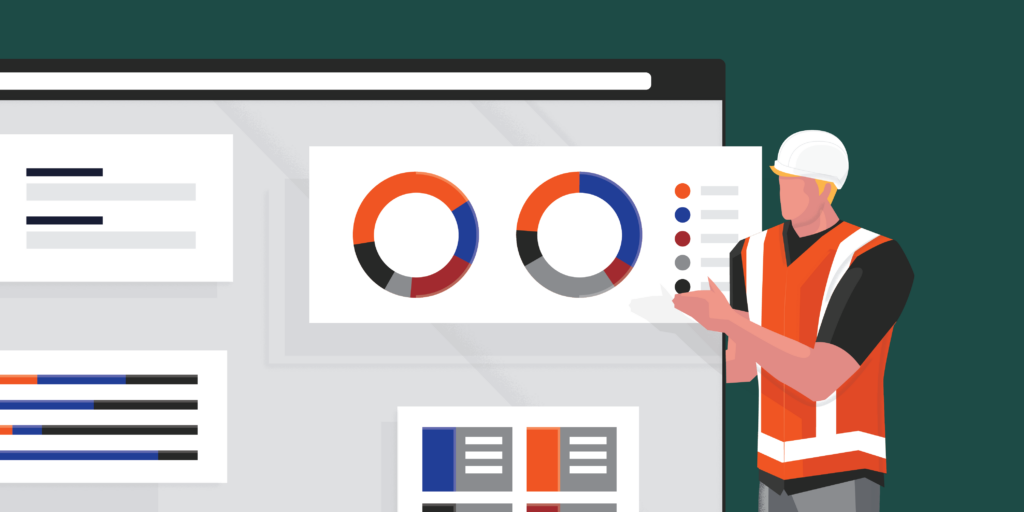— 4 min read
Construction Risk Management: 5 Steps to Reduce & Mitigate Risk
Last Updated Nov 29, 2023
Last Updated Nov 29, 2023

Table of contents
What is construction risk management?
Construction risk management is the process of identifying potential risks, evaluating their impact and implementing procedures to mitigate their financial effect on the business. Through this strategic process, construction firms can predict and minimize the likelihood of — and loss from — undesired events, while maximizing the rewards.
While the process involves a variety of tools, the foundation of any successful construction risk management program is built on data. Risk data comes in many forms, from internal cash flow statements to jobsite safety analyses to industry and economic reports. A company's ability to simultaneously maximize business results and minimize risk is directly tied to its ability to collect and analyze data on past performance — and continually look for lessons in its own history.
The 5-step construction risk management process
Risk management is an extremely complex topic, but the general process is the same regardless of the business scale. At its core, the construction risk management process includes identifying risks, assessing potential impact, controlling them, financing potential costs and seeking to recover damages when a loss occurs.
1. Identify risks
The process of identifying risks involves asking the question: What risks are presented by the project or customer? A risk is any threat that creates potential loss exposure. While risk can be categorized in many different ways, these are six common types of risks that construction companies need to identify.
Types of risks on construction projects
- Financial risk: Slow payments, spiking construction costs, fraud and other financial factors can squeeze cash flow and disrupt growth. This category includes credit risk and liquidity risk, among others.
- Safety risk: Construction is a dangerous industry, with high rates of injury and death from jobsite accidents.
- Operational or project risk: Schedule delays, workforce interruptions, lack of funding, equipment failures and environmental conditions like hurricanes have the potential to derail business objectives.
- Economic risk: Recessions, inflation and other economic forces can shrink market opportunities, drive up construction costs and dry up project funding.
- Legal risk: Construction is both a heavily regulated and a highly litigious industry.
- Political risk: Of particular concern to global construction firms and companies that work on government projects, political risks include acts of terrorism, civil unrest or simply political changes that affect project timelines, funding and worker safety.
2. Assess impact
After identifying risks on the project, the next step is to determine the frequency, probability and severity of these potential risks. This involves asking several questions:
- "What is the worst that could happen?"
- "What is the likelihood of that event?"
- "How much would we lose if it occurred?"
During the assessment of the project, the company determines the probability of a loss event and the severity of the damages.
Recording tracking project and financial data is a key component of assessing risk. The more historical data a company has to analyze, the more accurate its risk assessment will be. A contractor tendering on their first hospital project will have a much less accurate picture of their risk than a contractor with ten years of performance, safety and financial reports on hospital projects.
3. Prepare a response
A company has four potential responses to an identified risk: accept it, avoid it, control it or transfer it.
- Accept the risk: Certain risks are deemed acceptable – the cost of pursuing a valuable opportunity.
- Avoid the risk: This may involve changing the scope of work or declining the contract entirely.
- Control the risk: A business can implement measures to reduce the likelihood of a loss event, and/or mitigate its impact on the company. For example, a contractor may choose to protect lien rights with high-risk customers, or on projects of a certain size to reduce the impact of a missed payment.
- Transfer the risk: A contractor can pass the risk on to another party through the construction contract or with an insurance program.
4. Recover losses
When a loss occurs, the company should seek to recover damages and limit. Loss recovery and mitigation can take a number of different forms, including:
- Filing an insurance claim
- Filing a mechanics lien or payment bond claim
- Sending accounts to collections
- Filing a lawsuit
- Declaring bankruptcy
A construction company's risk management program should include policies and procedures for loss prevention and recovery when needed.
5. Review results
Contractors need to conduct periodic reviews of their risk management program – analyzing both successes and failures – and update the process with lessons learned.
Construction risk management is a process that requires constant improvement. Any risk management program should adapt to reflect past performance as well as changes in the industry overall. The landscape of risk in construction today looks much different than it did even ten years ago. The building industry of tomorrow will bring new risks – and new strategies to manage and mitigate them.
Categories:
Tags:
Written by
Harshil Gupta
24 articles
Harshil Gupta is a Product Marketing Manager at Procore. Backed by a stint in engineering and rich experience in growth and product marketing, he's enthusiastic about the role of technology in elevating and enabling other industries. He lives in Toronto.
View profileExplore more helpful resources

Equipped for Success: The Risks and Rewards of Construction Equipment
Even before written language, humans used tools to build. Contractors couldn’t have built the amazing feats seen and used in everyday life without machinery. From handheld tools to multi-storey tower...

The Percentage of Completion Method Explained
Accounting for income and expenses can present a real challenge for contractors, especially on long-term projects. The percentage of completion method is one of the most common methods of accounting...

What Is a General Contractor?
In the construction industry, a general contractor is the person or company responsible for overseeing a construction project. Property owners will typically hire general contractors to ensure a construction job...

MasterFormat: The Definitive Guide to CSI Divisions in Construction
Often referred to as the “Dewey Decimal System” of construction, the Construction Specifications Institute (CSI) MasterFormat is the industry standard in North America for organizing construction specifications. This system enables...